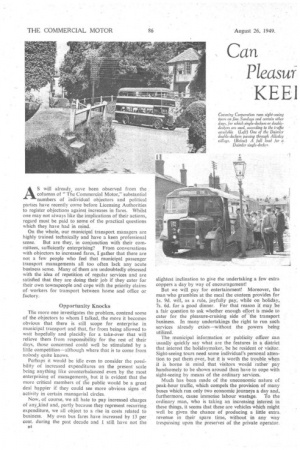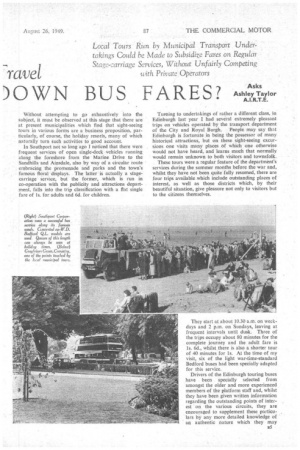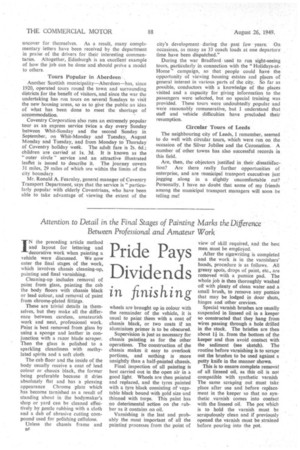Can Pleasur
Page 38

Page 39

Page 40

If you've noticed an error in this article please click here to report it so we can fix it.
"ravel
KEE1 )OWN BUS FARES?
As will already, nave been observed from the columns of "The Commercial Motor," substantial numbers of individual objectors and political parties have recently come before Licensing Authorities to register objections against increases in fares. Whilst one may not always like the implications of their actions, regard must be paid to some of the practical questions which they have had in mind.
On the whole, our municipal transport managers are highly trained technically and have a keen professional sense. But are they, in conjunction with their com mittees, sufficiently enterprising? From conversations with objectors to increased fares, I gather that there are not a few people who feel that municipal passenger transport managements all too often lack any acute business sense. Many of them are undoubtedly obsessed with the idea of repetition of regular services and are satisfied that they are doing their job if they cater for their own townspeople and cope with the priority claims of. workers for transport between home and office or factory.
Opportunity Knocks The more one investigates the problem, contend some of the objectors to whom I talked, the more it becomes obvious that there is still scope for enterprise in municipal transport and that, far from being allowed to wait hopefully and placidly for a take-over that will relieve them from responsibility for the rest of their days, those concerned could well be stimulated by a little competition—although where that is to come from nobody quite knows.
Perhaps it would be idle even to consider the possibility of increased expenditures on the present scale being anything like counterbalanced even by the most enterprising of managements, but it is evident that the more critical members of tfie public would be a great deal happier if they could see more obvious signs of activity in certain managerial circles.
Now, of course, we all hate to pay increased charges of any,lcind and, partly because they represent recurring expenditure, we all object to a rise in costs related to business. My own bus fares have increased by 13 per cent, during the past decade and I still have not the aLt slightest inclination to give the undertaking a few extra coppers a day by way of encouragement!
But we will pay for entertainment! Moreover, the man-who grumbles at the meal the canteen provides for ls. 9d. will, as a rule, joyfully pay, while on holiday, 7s. 6d. for a good dinner. For that reason it may be a fair question to ask whether enough effort is made to cater for the pleasure-cruising side of the transport business. In many undertakings the right to run such services already exists—without the powers being utilized.
The municipal information or publicity officer can usually quickly say what are the features in a district that interest the holidaymaker, be he resident or visitor. Sight-seeing tours need some individual's personal attention to put them over, but it is worth the trouble when it is borne in mind that visitors would rather pay handsomely to be shown around than have to cope with sight-seeing by means of the ordinary services.
Much has been made of the uneconomic nature of peak-hour traffic, which compels the provision of many buses which run only two economic journeys a day and, furthermore, cause immense labour wastage. To the ordinary man, who is taking an increasing interest in these things, it seems that these are vehicles which might well be given the chance of producing a little extra_ revenue in their spare time, without in any way trespassing upon the preserves of the private operator.
Without attempting to go exhaustively into the subject, it must be observed at this stage that there are at present municipalities which find that sight-seeing tours in various forms are a business proposition, particularly, of course, the holiday resorts, many of which naturally turn such activities to good account.
In Southport not so long ago I noticed that there were frequent services of open single-deck vehicles running along the foreshore from the Marine Drive to the SandhiIls and Ainsdale, also by way of a circular route embracing the promenade and parks and the town's famous floral displays. The latter is actually a stagecarriage service, but the former, which is run in co-operation with the publicity and attractions department, falls into the trip classification with a flat single fare of Is. for adults and 6d. for children.
Turning to undertakings of rather a different class, in Edinburgh last year I had several extremely pleasant trips on vehicles operated. by the transport department of the City and Royal Burgh. People may say that Edinburgh is fortunate in being the possessor of many historical attractions, but on these sight-seeing excursions one visits many places of which one otherwise would not have heard, and learns much that normally would remain unknown to both visitors and townsfolk.
These tours were a regular feature of the department's services during the summer months before the war and, whilst they have not been quite fully resumed, there are four trips available which include outstanding places of interest, as well as those districts which, by their beautiful situation, give pleasure not only to visitors but to the citizens themselves.
They start at about 10.30 a.m. on weekdays and 2 p.m. on Sundays, leaving at frequent intervals until dusk. Three of the trips occupy about 80 minutes for the complete journey and the adult fare is Is. 6d., whilst there is also a shorter tour. of 40 minutes for ls. At the time of my visit, six of the light war-time-standard Bedford buses had been specially adapted for this service.
Drivers of the Edinburgh touring buses have been specially selected from amongst the older and more experienced members of the platform staff and, whilst they have been given written information regarding the outstanding points of interest on the various circuits, they are encouraged to supplement these particulars by any more detailed knowledge of an authentic nature which they may uncover for themselves. As a result, many complimentary letters have been received by the department in praise of the drivers for their interesting commentaries. Altogether, Edinburgh is an excellent example of how the job can be done and should prove a model to others.
Tours Popular in Aberdeen Another Scottish municipality—Aberdeen—has, since 1920, operated tours round the town and surrounding districts for the benefit of visitors, and since the war the undertaking has run tours on several Sundays to visit the new housing areas, so as to give the public an idea of what has been done to meet the shortage of accommodation.
Coventry Corporation also runs an extremely popular tour as an express service twice a day every Sunday between Whit-Sunday and the second Sunday in September, on Whit-Monday and Tuesday, August Monday and Tuesday, and from Monday to Thursday of Coventry holiday week. The adult fare is 2s. 6d.; children are carried at Is. 3d. It is known as the "outer circle" service and an attractive illustrated leaflet is issued to describe it. The journey covers 31 miles, 29 miles of which are within the limits of the city boundary.
Mr. Ronald A. Fearnley, general manager of Coventry Transport Department, says that the service is "particularly popular with elderly Coventrians, who have been able to take advantage of viewing the extent of the city's development during the past few years. On occasions, as many as 33 coach loads at one departure time have been dispatched."
During the war Bradford used to run sight-seeing tours, particularly in connection with the " Holidays-atHome " campaign, so that people could have the opportunity of viewing housing estates and places of general interest in various parts of the city. So far as possible, conductors with a knowledge of the places visited and a capacity for giving information to the passengers were selected, but no special training was provided. These tours were undoubtedly popular and wefe reasonably remunerative, but I understand that staff and vehicle difficulties have precluded their resumption.
Circular Tours of Leeds The neighbouring city of Leeds, I remember, seemed to do well with circular tours, which were run on the occasion of the Silver Jubilee and the Coronation. A number of other towns has also successful records in this field.
Are, then, the objectors justified in their dissatisfaction? Are there really further opportunities of enterprise, and are municipal transport executives just jogging along in a slightly uncomfortable rut? Personally, I have no doubt that some of my friends among the municipal transport managers will soon be telling me!




















































































